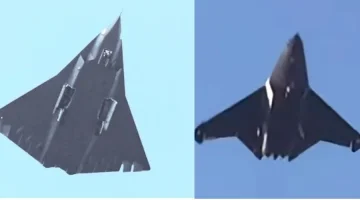- Views: 2K
- Replies: 10
A debate over the future of India's air combat strategy has emerged following recent remarks by Dr. Kota Harinarayana, the celebrated chief designer of the LCA Tejas aircraft.
He suggested that India possesses the technological capability to develop a sixth-generation unmanned fighter based on a "flying wing" design, similar to the prototype tested under the Ghatak UCAV program.
This concept, notable for its complete lack of a conventional tail, offers exceptional stealth characteristics. However, an analysis of next-generation fighter programs in the United States, Europe, and China indicates that leading air powers are pursuing a different path.
This raises a critical question for the Indian Air Force (IAF): Is the stealth-focused flying wing the right choice, or does a more balanced design hold the key to future air dominance?
India's Breakthrough with Flying Wing Technology
India has achieved a significant milestone in advanced aeronautics with its Stealth Wing Flying Testbed (SWiFT), a sub-scale technology demonstrator for the Ghatak Unmanned Combat Aerial Vehicle (UCAV) program.Managed by the Defence Research and Development Organisation (DRDO), this project has successfully proven that a tailless aircraft can be flown with stability.
Dr. Harinarayana highlighted this achievement as evidence of India's readiness for a sixth-generation platform.
A flying wing's design is inherently stealthy because its smooth profile, free of vertical and horizontal fins, offers a very low radar cross-section (RCS).
Overcoming the natural instability of such an airframe requires highly sophisticated flight control computers and software, a technological hurdle that Indian engineers have successfully cleared in tests.
The Limits of a Flying Wing in Air Combat
While the flying wing is an excellent design for stealth bombers, like the American B-2 Spirit, its suitability as a fighter jet is limited. The primary drawback is a lack of agility.Traditional tail fins provide the control needed for rapid, high-angle-of-attack manoeuvres essential in a dogfight. Without them, a flying wing can be less nimble.
Furthermore, flying wing designs often require larger wingspans, which can reduce top speed and responsiveness compared to more compact fighter jets.
As a result, while Dr. Harinarayana's vision is technologically ambitious, it may not align with the multi-role requirements of a sixth-generation fighter, which must balance stealth with speed, agility, and advanced combat systems.
Global Trends in 6th-Generation Fighter Design
A survey of the world's most advanced air combat programs reveals a consensus on a hybrid design philosophy that stops short of a pure flying wing.- United States: The U.S. Air Force's Next Generation Air Dominance (NGAD) program, for which a design has reportedly been selected, features a large, tailless, blended-wing-body shape. It prioritises range, payload, and stealth for beyond-visual-range combat but is not a pure flying wing, retaining features for superior performance. The U.S. Navy's parallel F/A−XX program also seeks a balance between stealth, speed, and payload capacity.
- United Kingdom, Japan & Italy: The Global Combat Air Programme (GCAP), previously known as Tempest, features a tailless design but incorporates small, angled "canted" vertical stabilisers. This solution provides directional control and agility while maintaining a very low radar profile.
- France, Germany & Spain: The Future Combat Air System (FCAS) program, led by Dassault Aviation, is developing a Next Generation Fighter (NGF). Its design also features a delta-like wing and canted stabilisers to ensure it is agile enough for both air-to-air and air-to-ground missions.
- China: Concepts from Chinese firms like Chengdu and Shenyang show tailless or near-tailless designs. Recent prototypes, including a trijet flying wing, incorporate features like lambda-shaped wings and specialised control surfaces to enhance manoeuvrability, acknowledging the agility limitations of a pure flying wing.
The Way Forward for India
The international trend is clear: the most advanced future fighters blend stealth with the speed and agility of traditional designs. A pure flying wing, while exceptionally stealthy, sacrifices the versatility required on a modern battlefield.These aircraft must perform a range of missions, from stealthy strikes to close-quarters air superiority.
India can leverage its considerable experience from developing the LCA Tejas Mk2 and the fifth-generation Advanced Medium Combat Aircraft (AMCA).
The knowledge gained from the Ghatak program's flying wing is invaluable for creating stealth platforms. However, for its sixth-generation fighter, the IAF should consider a design that combines this stealth expertise with the proven agility of a tailed or canted-stabiliser configuration.
This balanced approach would ensure India develops a competitive and truly multi-role fighter for the challenges of future warfare.

